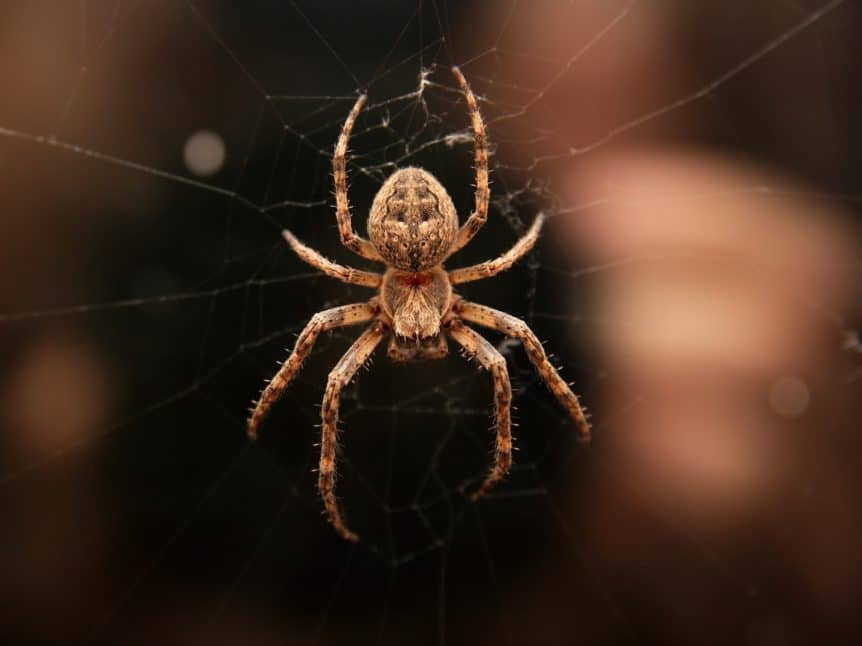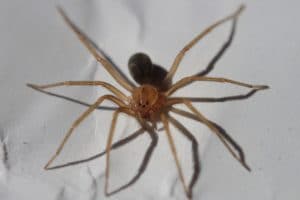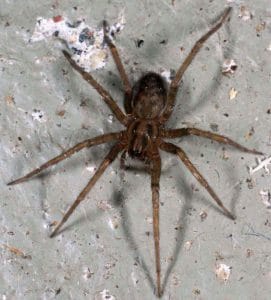You are not alone if you hate spiders! Chances are these 7 common house spiders in Florida homes are roaming around. Hopefully not in your house at the same time! Since it’s possible any of these spiders could be found in and around your house, we wanted to give you some helpful information. Spiders prefer to be hidden and tucked away in dark corners, behind furniture or under dressers. They don’t stalk humans, or even want to bite us. Usually bites occur when the spider is accidentally squeezed or pinched by people. Pests including spiders should not be in your home.
Poisonous spiders like black widows and brown recluse spiders most likely can be found on the outside of your home, resting quietly in undisturbed piles of debris like, cardboard boxes, wood piles and outdoor furniture. A proactive way to eliminate the likelihood of pests is by removing their shelter and food sources. Spiders are a valuable part of the ecosystem helping to eliminate a number of pests that you don’t want around your house. So while spiders can be scary to some, they really are good insects to have around.
7 Common House Spiders in Florida Homes
Black Widow
1. Black Widow (The Latrodectus genus): Females are shiny black. Most have a red hourglass shape, or red spots on the underside of the abdomen. Look to the distinctive body shape to identify. Males are dark gray or brown, and if they have an hourglass shape it is yellow or white. Found in woodpiles, stone walls, outdoor furniture or railings. Also garages, sheds, barns, basements and crawlspaces. Of course, we are you sure don’t want to get too close to try and identify a spider. Only the females bite, and the bite can be very painful, however its rarely fatal. If you are bitten by a spider and you are unable to catch and identify the spider, you might want to get it checked out. Every person reacts differently and its possible you could have an allergic reaction. The good news is they rarely attack and bit humans. When scared they tend to play dead and usually bite only when unintentionally pinched or squeezed.
Brown Recluse
2. Brown Recluse (Loxosceles reclusa): Light to dark brown, often with violin-shaped markings on their back, with the neck of the violin pointing to the abdomen. Since the violin is not always present, the best way to identify the recluse is by observing the eyes. Most spiders have eight eyes; recluse spiders have six eyes arranged in pairs. Found in sheds, garages, basements and woodpiles. Also dressers, cardboard boxes and behind baseboards and pictures.
Daddy Long Legs
3. Daddy Long Legs (The Opiliones order): Pale yellow to light brown or gray. Exceptionally long, thin legs. A fused body with no distinct head or abdomen. Found in: damp places such as basements, and crawlspaces. Also corners of garages, windows, ceilings, closets, as well as sink cabinets and bath traps and in other shelters. This is one of the most common house spiders in Florida.
House Spider
4. Domestic House Spider (Tegenaria domestica): Dark orange or brown, with a pale mark on the breastplate. Dark bands on legs. A V-shaped pattern runs lengthwise across the top of the abdomen. Distinctive funnel shaped web. Found in: dark crevices behind furniture, cupboards. Also attics, basements, closets, storage rooms and other undisturbed places. They rarely bite and if they do its painless to humans and does not cause any problems. Even though this spider is commonly found in Florida, they are easy removed by catching in a cup and taking outside. Male spiders live about one year while females lives as long as seven years.
Jumping Spider
5. Jumping Spider (The Salticidae family): A variety of colors and sizes, they are recognized by their jumping behavior and rectangular-shaped faces with eight eyes in two distinct rows. Found in: cracks of hardwood floors, under furniture, in folds of drapery, between shelved books, the underside of doors and window molding.
Southern House Spider
6. Southern House Spider (Kukulcania hibernalis): Males are uniformly brown, with slender bodies. They sometimes have a violin-like markings. Females have compact bodies that are dark brown or black. Both are covered in fine hair. Found in: dark recesses of windowsills, shutters, overhangs and other dark areas. The females stay close to their webs, but the males wander in search of prey and females.
Yellow Sac Spider
7. Yellow Sac Spider (Cheiracanthium genus): Usually pale, ranging from yellow to beige. The first pair of legs are longer than the others. Legs have dark tips. Found in: corners where the ceiling and wall meet, behind picture frames, along the wall and ceiling, along baseboards. Also, wood piles and other undisturbed areas.
Spider and Pest Extermination Services
With Lawn Care Extraordinaire’s prompt spider extermination services, which is included in our regular pest control services, Florida homes and businesses can successfully remove common house spiders in Florida and eliminate the risk of such spider infestations in the future. We trust our expertise and the products that we use – that is why we offer a guarantee in case you are not 100% satisfied with the results.
Give us a call today or complete our online form!




